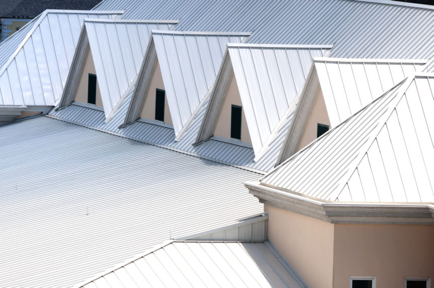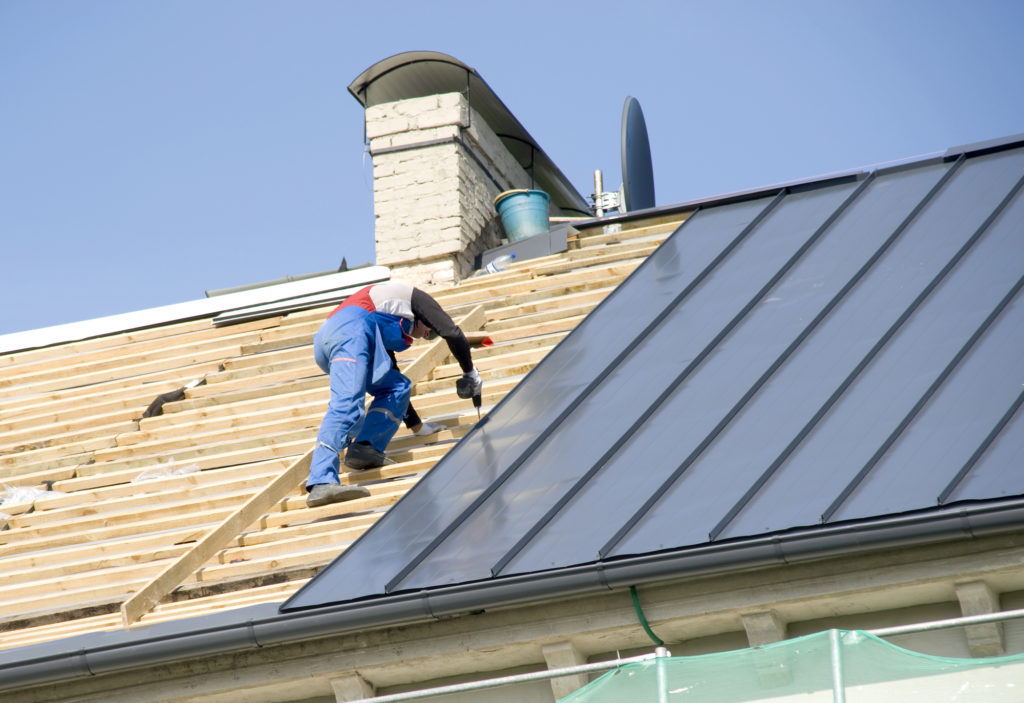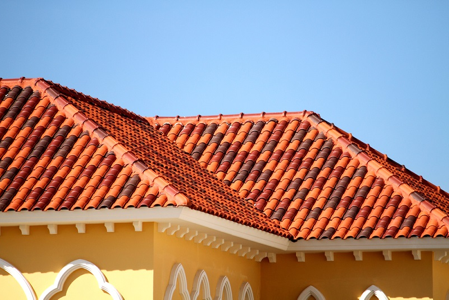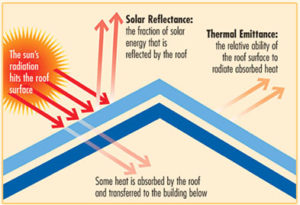
If your home needs a new roof, don’t be too quick to automatically assume you should replace the asphalt shingles you probably already have with more of the same. We’ve teamed up with roofing contractor Contractor Quotes to send up a warning flag about asphalt shingles and give you 7 eco-friendly roof options to consider. And of course, always talk to a professional to discuss the best options for you, given your budget, needs, preferences and concerns about the environment.
What’s Wrong With Asphalt?
There are two big problems with asphalt shingles.
One, they are not easy to recycle.
Asphalt shingles may contain asbestos, lead, cadmium and polycyclic aromatic hydrocarbons (PAHs), among other toxic chemicals.
Even though asbestos is not to have been used in shingle manufacturing since the 1980s, often, one shingle roof is installed directly on top of another. Old shingles that contain asbestos could be found if the old roof is ripped off completely and an entirely new roof installed. Because asphalt shingles contain an amalgam of materials, it can be hard to incorporate them into other products.
The PAHs they contain come from the petroleum products used to manufacture shingles. The PAHs don’t appear to leach out of the shingles themselves. However, PAHs are emitted when the shingles are originally made. Some PAHs are known to cause cancer, says the U.S. Centers for Disease Control.
The second problem with asphalt shingles is that they contaminate the water that runs off them.
Researchers at the University of Michigan College of Engineering found high levels of lead in rainwater that came from the roof. This could be a problem for people who collect rainwater in barrels to water their gardens. It’s also a source of contamination for our groundwater, since so much rain water slides off our roofs, into our gutters, and then into the street and street sewers.
8 Eco-Friendly Roof Options to Consider
Here are 8 eco-friendly roof options that don’t contain asphalt.
White or “Cool” Roof – The aptly-nicknamed “cool roof” consists of a mixture of white gravel and glue. It reflects the sun’s rays, helping your home stay cooler in the summer. Energy Star-qualified cool roofs can lower the roof’s surface temperature by up to 100 degrees F. That could cut your air conditioning use by 10% to 15%.
Wood Shingles – Wood shingles can be made out of reclaimed or recycled wood and last up to 20 years. When it’s time to replace the roof, you can recycle the shingles, lengthening the lifespan of the wood.
Solar Shingles – Shingles made from photovoltaic cells offer an increasingly popular alternative to solar panels mounted on roofs. The shingles, like those pictured above, are cost-competitive with solar panels and can be integrated into the roof so you can barely tell they’re there. Federal and state tax credits offset the cost of the shingles, and you’ll get additional savings – maybe as much as 40% to 60% – because the panels could cut your utility bill so drastically.
Metal Roofs – Metal roofs are very durable and long-lasting. They will reflect the sun’s rays well to help lower your energy bills. The metal can contain a high degree of recycled content and can also be recycled at the end of its life.
Slate Tiles – Slate is so durable, some manufacturers offer a 100 year warranty. You can also use salvaged slate tiles that have been repurposed by the manufacturer.
Clay and Concrete Tiles – Clay tiles are very good at reflecting heat, so will help reduce your utility bills. They are also fully recyclable. One down side of clay tiles is that they can be energy intensive to manufacture. Concrete tiles can look like clay but don’t use quite as much energy to manufacture.
Rubber Roof – A rubber roof is usually made out of reinforced rubber shingles that are manufactured from used steel-belted radial tires. Rubber is very durable and long-lasting. It can be manufactured to look like either slate or shake tiles and can be very beautiful.

Garden/Green Roof – Planting your roof with vegetation can help cool your home, improve insulation, and help clean the air. Green roofs combat the “heat island effect” that raises temperatures in so many cities. And if you opt to plant an actual garden, you can grow food and flowers on your roof, which is terrific if you don’t have any space on your ground-level property.
Questions to Ask When Considering Eco-Friendly Roof Options
Before you buy a roof no matter what kind of roofing materials you’re considering, ask the following questions:
* What is the roofing material made of?
* Is your home’s existing frame strong enough to withstand the roof being proposed?
* How does the roof rate when it comes to Energy Star and LEED, the U.S. Green Building Council standards for eco-friendly building materials?
* How long will the roof last? It should be under a specific warranty for years of performance.
* Will the old roof be recycled?
* What kind of maintenance is required? A “green” roof covered with vegetation will require more maintenance than a roof made of recycled rubber tiles.
* Is the roofing contractor highly experienced and highly rated on sites like Angie’s List, neighborhood listservs, the Better Business Bureau, or other independent sites that verify the quality of the roofer’s work?
If you’ve installed an eco-friendly roof, what did you choose and why?
NOTE: Though we team up with a variety of companies to bring you information and expertise, our editorial opinions remain our own. Thanks for any suggestions you have that will help us improve the content we offer you.

















6 thoughts on “Why These 8 Eco-Friendly Roof Options Don’t Include Asphalt Shingles”
These are really helping with combating Asbestos as well. Keeping your quality of life much higher.
Yes! Thanks for writing.
[…] Related: Why These 8 Eco-Friendly Roof Options Don’t Include Asphalt Shingles […]
Thanks for visiting and providing your list.
Hello
You did an excellent job on this post! It’s a great and helpful article.
Thank you so much for sharing amazing content.
Is asphalt the very best for green roofs? Certainly not. It is also far from the worst. Many are even Energy Star rated.
Between 1963 and the mid-1970s, some manufacturers did use asbestos in the fiber mat of shingles. The typical life span of asphalt shingles of that era is 10-15 years. It is against code to apply more than two layers of roofing in most jurisdictions so even if you re-roofed at the tail end of that experiment then the chance of having this issue over 45 years later is very slim. In King County, Washington, where we often work, shingles are recycled into roadways. Interestingly, recyclers have been testing for asbestos in shingles and have found less than 1 percent. Source: http://www.shinglerecycling.org/content/asbestos-asphalt-shingles
It is also inaccurate that lead runoff is a significant concern in asphalt shingles. In that one “study”, they were working on a Victorian roof which is likely to have lead in the flashing, actual lead gutters, or any of the other metal elements on the roof. SOURCE: https://www.improvementcenter.com/blog/metal-roofs-making-comeback-asphalt-roofs-toxic-lead.html The Washington State Department of Ecology did a very precise runoff test on multiple roofing types with glass as a baseline. EPDM and Zinc roofing were the only ones with higher lead results. Source: https://apps.ecology.wa.gov/publications/documents/1403033.pdf
Leaving behind lead and asbestos, in the Washington roofing study, one of the more hazardous runoff issues was found to be among wood shingles because of the chemical treatment required to resist fire, insects, and vegetation in our damp, marine climate.
Due to the ease of recycling, most metal roofs are good, except for two types: Zinc and Copper roofing were found to have run-off concerns.
In the end, options that are fundamentally safe plus long-lasting are best. Most modern materials should last over 40 years. This will vary significantly based on your climate, system selection, and roof geometry.
We love what you are doing here and respect your commitment to the cause of a healthy home and environment. Keep up the good work.
Comments are closed.